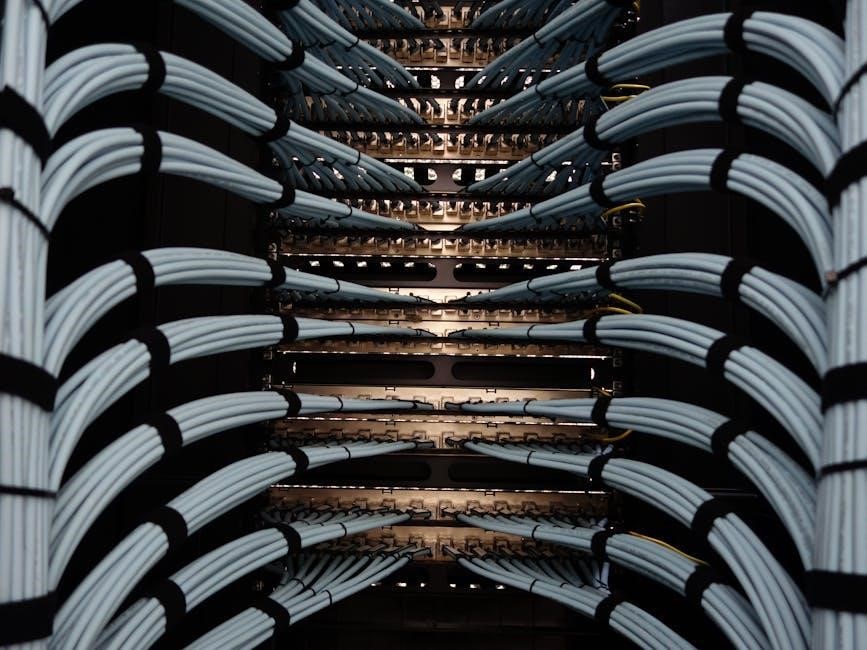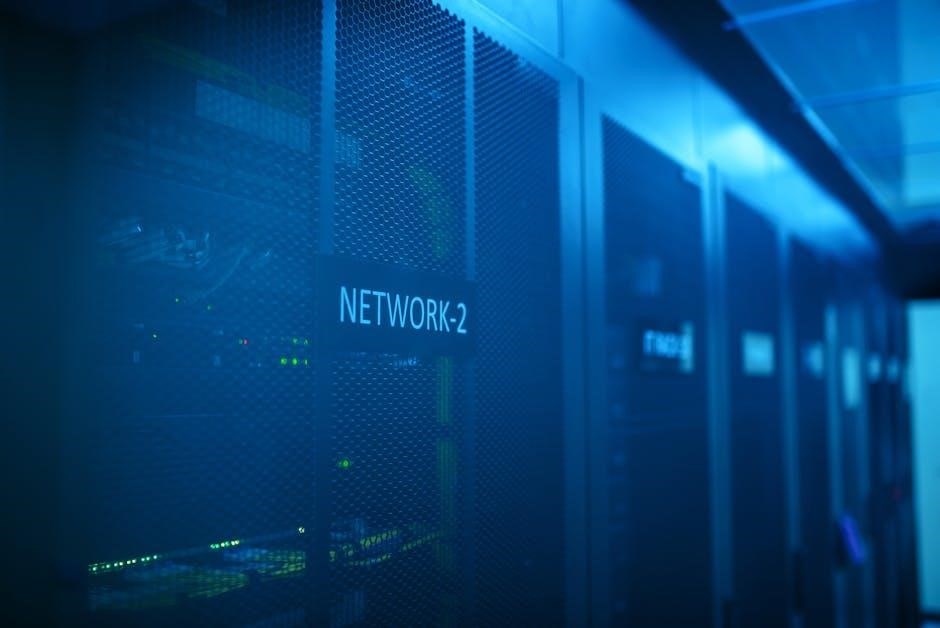Efficient data center infrastructure design is crucial for supporting IT operations, ensuring scalability, and maintaining high reliability. It involves careful planning of physical and network infrastructure to optimize performance, security, and energy efficiency while aligning with business objectives.
1.1 Importance of Efficient Data Center Design

Efficient data center design is critical for ensuring scalability, reliability, and optimal performance. A well-planned infrastructure supports growing IT demands while minimizing operational costs. It ensures uninterrupted service delivery, which is vital for business continuity. By optimizing power, cooling, and space, efficient design reduces energy consumption and environmental impact. Additionally, it future-proofs the infrastructure, adapting to emerging technologies and evolving business needs. A poorly designed data center can lead to increased downtime, higher expenses, and scalability challenges. Therefore, prioritizing efficient design is essential for maintaining competitiveness and supporting long-term organizational goals. It also ensures compliance with industry standards, enhancing overall operational efficiency and reliability.
1.2 Key Components of Data Center Infrastructure
The key components of data center infrastructure include physical and network elements essential for seamless operations. Power supply and distribution systems ensure reliable energy delivery, while cooling systems maintain optimal temperatures. Structured cabling infrastructure provides a robust network backbone, supporting data transmission. Server and storage systems house and manage data, while network architecture enables efficient data flow. Security measures, both physical and cybersecurity, protect against threats. Additionally, monitoring and management tools like DCIM software optimize performance and resource utilization. These components work together to create a scalable, efficient, and secure environment for IT operations. Their proper design and integration are critical for meeting business demands and ensuring high availability;
1.3 Challenges in Modern Data Center Design
Modern data center design faces several challenges, including rising energy consumption, the need for scalability, and the integration of emerging technologies. Ensuring energy efficiency while meeting growing demand is critical, as data centers already consume a significant portion of global power. Additionally, physical infrastructure design must accommodate advancements like AI and high-density computing, requiring robust cooling and power systems. Another challenge is the implementation of Data Center Infrastructure Management (DCIM) tools, which automate and optimize operations but can be complex to deploy. Finally, balancing sustainability with performance and cost remains a significant hurdle, as organizations strive to reduce their environmental impact while maintaining high availability and reliability. Addressing these challenges requires careful planning and innovative solutions.

Data Center Standards and Compliance
Data center standards like TIA-942 and Uptime Institute’s Tier Standards ensure reliability, redundancy, and fault tolerance. Compliance with these frameworks is essential for maintaining operational efficiency and security.
2.1 Overview of TIA-942 Standards
The TIA-942 standard provides comprehensive guidelines for designing and building data centers, ensuring reliability and efficiency. It covers infrastructure components such as power, cooling, cabling, and security. The standard categorizes data centers into four tiers, each with specific requirements for redundancy and fault tolerance. By adhering to TIA-942, organizations can achieve scalable and resilient facilities. This framework is widely adopted globally, ensuring consistency and excellence in data center infrastructure design. Proper implementation of these standards helps reduce risks and optimizes performance, making it a cornerstone for modern data center construction and operations.
2.2 Uptime Institute’s Tier Standards for Data Centers
The Uptime Institute’s Tier Standards are a globally recognized framework for evaluating data center infrastructure based on reliability, redundancy, and fault tolerance. The standards categorize data centers into four tiers, from Tier I (basic capacity) to Tier IV (fully fault-tolerant). Each tier specifies requirements for power, cooling, and infrastructure redundancy to ensure uninterrupted operations. Tier IV, the highest certification, demands concurrent maintainability, meaning no single failure can impact IT operations. These standards guide organizations in designing and operating data centers that align with their business continuity needs. By adhering to these standards, data centers can achieve optimal performance, scalability, and resilience, ensuring high availability for critical IT infrastructure.
2.3 Compliance Requirements for Data Center Infrastructure
Compliance requirements for data center infrastructure ensure adherence to industry standards, regulations, and best practices. These requirements encompass a wide range of factors, including physical security, environmental sustainability, and operational efficiency. Standards such as EN 50600, TIA-942, and BICSI 002 provide guidelines for construction, power supply, cooling, and cabling systems. Additionally, data centers must comply with local building codes, fire safety regulations, and energy efficiency benchmarks. Failure to meet these requirements can result in legal penalties, increased operational risks, and higher costs. Compliance also extends to cybersecurity frameworks, ensuring the protection of sensitive data. By integrating compliance into the design and operations, data centers can maintain reliability, reduce risks, and align with global best practices for infrastructure management and sustainability.

Physical Infrastructure Design
Physical infrastructure design involves planning and implementing power distribution, cooling systems, and structured cabling to ensure reliability, efficiency, and scalability while supporting maintenance and future upgrades.
3.1 Power Supply and Distribution Systems
Power supply and distribution systems are critical for ensuring uninterrupted operations in data centers. These systems must provide redundant and efficient power delivery to IT equipment while minimizing energy waste. Key components include uninterruptible power supplies (UPS), generators, and power distribution units (PDUs). Proper design ensures that power is distributed safely and reliably, with built-in redundancy to handle failures. Advanced technologies like modular power systems and intelligent PDUs optimize energy usage and simplify management. Regular maintenance and monitoring are essential to prevent outages and ensure compliance with industry standards. A well-designed power infrastructure supports scalability and future upgrades, aligning with the data center’s evolving needs.
3.2 Cooling Systems and Thermal Management
Cooling systems and thermal management are essential for maintaining optimal operating temperatures in data centers. Proper airflow management, such as hot aisle and cold aisle configurations, ensures efficient heat removal. Advanced cooling technologies, including CRAC (Computer Room Air Conditioning) units, chilled water systems, and evaporative cooling, are commonly used. Direct liquid cooling and hybrid systems are gaining popularity for high-density environments. Energy efficiency is a key consideration, with strategies like airside and waterside economization reducing power consumption. Monitoring tools and sensors help maintain precise temperature control, while regular maintenance ensures system reliability. Effective thermal management not only protects equipment but also supports overall data center performance, scalability, and sustainability.
3.3 Structured Cabling Infrastructure
A well-planned structured cabling infrastructure is critical for ensuring high-speed, reliable data transmission in data centers. It involves the installation of standardized cabling systems, including fiber-optic and twisted-pair cables, to support network connectivity. Proper cable management enhances scalability, flexibility, and redundancy, while minimizing signal interference. Standards like TIA-942 provide guidelines for designing and implementing cabling systems that meet performance and reliability requirements. Modern solutions often incorporate modular components, such as patch panels and MPO connectors, to simplify upgrades and reduce downtime. Efficient cabling also supports energy efficiency and thermal management by reducing cable congestion and improving airflow. Regular testing and documentation are essential to ensure optimal performance and compliance with industry standards, enabling seamless communication between physical and virtual infrastructure.

Network Architecture and Design
Robust network architecture is essential for efficient data center operations, ensuring scalability, reliability, and high performance. Modern designs leverage multi-tier models and DCIM tools for optimal connectivity and management.
4.1 Multi-Tier Data Center Design Models
A multi-tier data center design is a widely adopted architecture that organizes infrastructure into distinct layers, each serving specific functions. This model typically includes core, distribution, and access tiers, enabling scalable and efficient traffic management. It supports various web service architectures, such as Microsoft .NET and Java 2 Enterprise Edition, by separating functions like routing, switching, and server connectivity. This design enhances redundancy, simplifies network management, and allows for cost-effective scalability. By isolating critical functions, multi-tier models improve fault tolerance and ensure high availability. They are particularly beneficial for large-scale data centers, offering a structured approach to meet growing demands while maintaining performance and security.
4.2 Role of Data Center Infrastructure Management (DCIM) Software
Data Center Infrastructure Management (DCIM) software plays a critical role in optimizing data center operations by automating and orchestrating key processes. It provides real-time monitoring and management of physical and logical infrastructure, enabling efficient resource utilization. DCIM tools streamline capacity planning, asset tracking, and energy management, reducing manual intervention. They also enhance situational awareness, allowing data center managers to proactively address potential issues. By integrating with power, cooling, and network systems, DCIM software ensures holistic oversight and improves overall efficiency. Its automation capabilities support scalability and future-proofing, making it an essential tool for modern data centers. DCIM solutions are vital for maintaining operational excellence and aligning infrastructure with business demands.

Sustainability and Energy Efficiency
Sustainability and energy efficiency are critical in modern data center design, focusing on reducing environmental impact while optimizing performance. Strategies include optimizing power and cooling systems, integrating renewable energy sources, and implementing best practices to minimize energy consumption, ensuring eco-friendly and cost-effective operations.
5.1 Best Practices for Reducing Energy Consumption
Implementing best practices for reducing energy consumption in data centers involves optimizing power and cooling systems. One key strategy is improving cooling efficiency through the use of free cooling techniques, such as air-side or water-side economization, which reduce the need for mechanical cooling. Additionally, upgrading to high-efficiency servers and storage solutions can lower energy usage. Power usage effectiveness (PUE) should be monitored and minimized by ensuring that power distribution systems are efficient and that there is minimal energy loss. Another important practice is implementing server virtualization, which consolidates workloads and reduces the number of physical servers, thereby lowering overall energy consumption. Energy-efficient infrastructure designs, such as modular data centers, can also play a significant role in reducing operational costs and environmental impact.

5.2 Renewable Energy Integration in Data Centers
Integrating renewable energy into data centers is essential for reducing their environmental impact and operational costs. According to a report by the European Commission, data centers consume between 1.8% and 2.6% of Europe’s total energy, highlighting the need for sustainable solutions. Schneider Electric has introduced a guide to address physical infrastructure challenges, emphasizing the role of renewable energy in supporting AI and high-performance computing. On-site solar and wind installations, as well as power purchase agreements (PPAs), are increasingly being adopted to power data centers. Energy storage solutions, such as batteries, further enhance reliability and ensure a stable energy supply. These practices align with global sustainability goals and help data centers achieve long-term energy independence while reducing their carbon footprint.

Data Center Security
Data center security involves physical and cybersecurity measures to protect infrastructure, applications, and data. It includes access controls, surveillance, encryption, and compliance with standards like TIA-942.
6.1 Physical Security Measures
Physical security is a cornerstone of data center protection, ensuring the integrity of infrastructure and assets. Key measures include multi-layered access controls, such as biometric scanners and card readers, to prevent unauthorized entry. Surveillance systems, including CCTV cameras and motion detection, provide real-time monitoring of facilities. Additionally, environmental monitoring systems detect potential threats like fire or flooding. Mantrap doors and anti-tailgating systems further enhance access control. Schneider Electric and Cisco offer robust solutions for physical security integration. Regular audits and compliance with standards like TIA-942 ensure adherence to best practices. These measures safeguard against breaches, vandalism, and natural disasters, ensuring continuous operations and data integrity.
6.2 Cybersecurity Best Practices for Data Centers
Cybersecurity in data centers requires a multi-layered approach to protect sensitive data and infrastructure. Implementing firewalls, intrusion detection systems, and encryption ensures data integrity. Regular software updates, vulnerability assessments, and patch management mitigate risks. Role-based access control limits unauthorized system access. Cisco recommends segmenting networks to isolate critical systems. Encryption protects data in transit and at rest. Schneider Electric emphasizes securing IoT devices in modern data centers. Security information and event management (SIEM) systems monitor threats in real time. Compliance with standards like GDPR and ISO/IEC 27001 is essential. Training staff on security best practices strengthens overall defense. These measures ensure robust protection against cyber threats, maintaining trust and operational continuity in data centers.

Future-Proofing Data Center Design
Modular infrastructure, scalability, and adaptability are key to future-proofing data centers, enabling them to evolve with emerging technologies and support growing demands without compromising efficiency or performance.
7.1 Scalability Considerations
Designing a scalable data center involves planning for future growth without compromising current efficiency. Modular infrastructure, such as incremental power and cooling systems, allows for phased expansion. Scalability ensures that the data center can adapt to increasing demands, whether from new technologies or business growth. It is essential to consider both vertical and horizontal scaling options. Vertical scaling involves upgrading existing equipment to higher capacities, while horizontal scaling adds more equipment or facilities. Both approaches require careful planning to avoid over-provisioning and unnecessary costs. Additionally, scalable network architectures, such as multi-tier designs, support flexibility and redundancy, ensuring the data center remains efficient and resilient as needs evolve over time. Proper scalability planning is critical to maintaining long-term operational efficiency and meeting future demands effectively.
7.2 Emerging Technologies in Data Center Infrastructure
Emerging technologies are transforming data center infrastructure, enabling greater efficiency, scalability, and innovation. Artificial intelligence (AI) and machine learning (ML) are being leveraged for predictive maintenance and optimizing resource utilization. Edge computing is reshaping data center architectures by decentralizing resources, reducing latency, and improving real-time processing. Additionally, advancements in liquid cooling and immersion cooling address growing thermal management challenges, offering more efficient alternatives to traditional cooling systems. Software-defined infrastructure and DCIM tools are streamlining operations, enhancing automation, and improving capacity planning. These technologies not only enhance performance but also support sustainability goals by reducing energy consumption and environmental impact, ensuring data centers remain agile and future-ready in an evolving digital landscape.
Implementation and Management

Effective implementation and management of data center infrastructure require strategic planning, continuous monitoring, and proactive maintenance to ensure optimal performance, reliability, and alignment with business goals.
8.1 Selecting the Right Data Center Location
Selecting the optimal data center location is critical for ensuring reliability, efficiency, and cost-effectiveness. Key considerations include proximity to users, access to reliable power and connectivity, and compliance with local regulations. Environmental factors such as natural disaster risks and climate conditions also play a significant role. Additionally, the availability of skilled labor and infrastructure support should be evaluated. Strategic site selection can minimize operational costs, reduce latency, and enhance overall performance. Tools and resources, such as DCIM software and site selection guides, can aid in making informed decisions. Ultimately, the chosen location must align with both current and future business needs to ensure long-term success.
8.2 Tools for Monitoring and Managing Data Center Infrastructure
Effective monitoring and management tools are essential for maintaining optimal data center performance. DCIM (Data Center Infrastructure Management) software provides real-time insights into power usage, cooling, and capacity, enabling proactive decision-making. Automation tools streamline operations, reducing manual errors and improving efficiency. Schneider Electric and CommScope offer comprehensive solutions for infrastructure monitoring. These tools also support capacity planning and forecasting, ensuring resources are utilized efficiently. Advanced analytics and alerts help identify potential issues before they escalate, minimizing downtime. By leveraging these technologies, data centers can enhance reliability, reduce operational costs, and ensure seamless performance. Investing in robust monitoring tools is critical for aligning with modern data center demands and achieving long-term sustainability.
8.3 Best Practices for Ongoing Operations and Maintenance
Implementing best practices for ongoing operations and maintenance is vital for ensuring the reliability and efficiency of data center infrastructure. Regular maintenance of power and cooling systems helps prevent downtime and extends equipment lifespan. Utilizing DCIM software enables real-time monitoring and management, optimizing resource allocation. Staff training on the latest technologies and procedures ensures smooth operations. Maintaining detailed documentation of infrastructure configurations and procedures is essential for transparency and compliance. Adhering to industry standards and compliance requirements safeguards data integrity and security. Proactive upgrades and capacity planning ensure scalability, while robust security protocols protect against physical and cyber threats. By following these practices, data centers can achieve operational excellence and support long-term business growth effectively.


